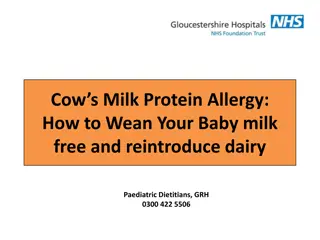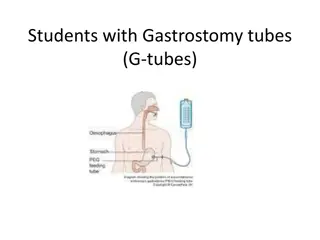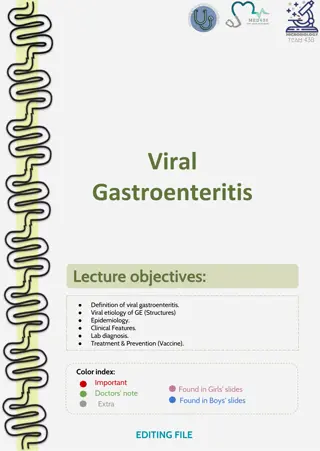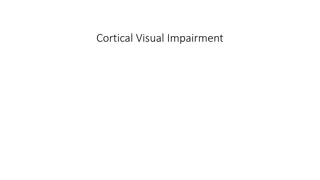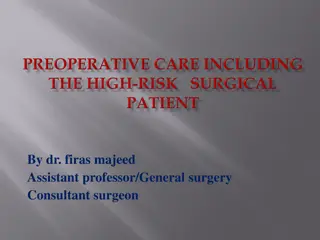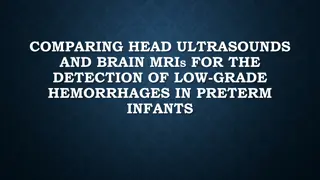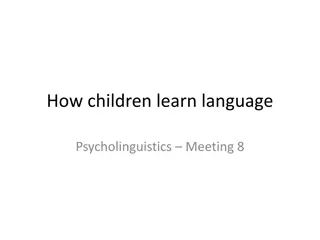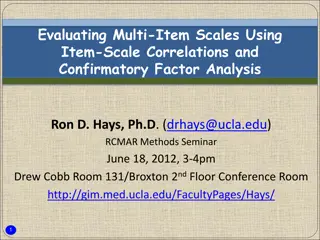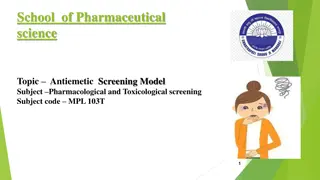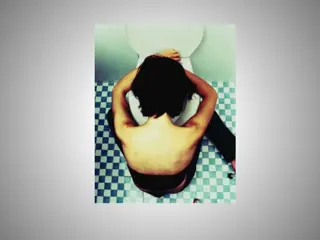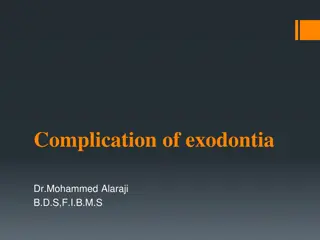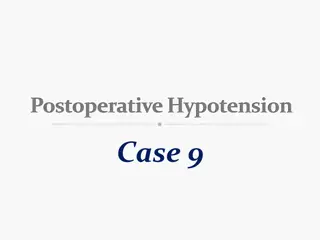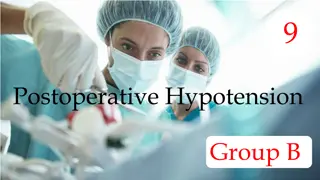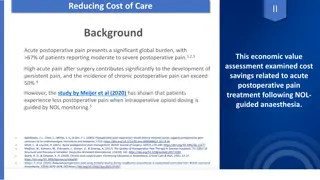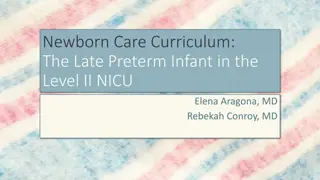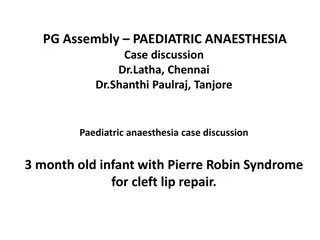Managing Postoperative Nausea and Vomiting in Infants and Children
Postoperative nausea and vomiting (PONV) is a significant concern in pediatric patients due to their increased risk compared to adults. This presentation by Dr. Jeannette Kierce covers the pathophysiology, risk factors, prophylaxis, and rescue treatments for PONV in infants and children, emphasizing the impact on post-anesthesia care unit (PACU) stay and overall well-being. Various factors, including patient age, anxiety, surgical type, and anesthesia agents, contribute to PONV risk, highlighting the importance of tailored interventions for this population.
Download Presentation

Please find below an Image/Link to download the presentation.
The content on the website is provided AS IS for your information and personal use only. It may not be sold, licensed, or shared on other websites without obtaining consent from the author. Download presentation by click this link. If you encounter any issues during the download, it is possible that the publisher has removed the file from their server.
E N D
Presentation Transcript
Managing PONV in Infants and Children Updated 2/2020 Jeannette Kierce, MD Children s Hospital of Richmond
Disclosures No relevant financial relationships
Learning Objectives: Pathophysiology of PONV Risk factors for PONV Interventions for prophylaxis Interventions for rescue treatment
PONV: Background PONV is one of the most unpleasant side effects of anesthesia The risk of pediatric PONV may be more than 2x that of adults Infants, children and developmentally delayed patients may not be able to communicate nausea well Many studies in pediatric patients only measure vomiting and show higher rates than adults Can delay PACU or hospital discharge Can lead to increased pain, dehydration, and electrolyte abnormalities
PONV: Pathways Cortex, Limbic System Cognitive and Emotional Input Emetogenic agents Vestibular Apparatus Motion induced nausea Solitary Tract Nucleus Chemoreceptor Trigger Zone Central Peripheral Vagus Nerve Increased Vasopressin Autonomic Nervous System Gastric Dysrhythmia Nausea Eur J Pharmacol 2014; 772:55-66
PONV: Targets Pain Vestibular Apparatus M, H1 Blood Brain Barrier CRTZ , 5HT3, D2 NTS , 5HT3, NK1 Central Peripheral Volatile Anesthetic Opioids Gut 5HT3, M = Muscarinic, H1= Histamine, = Opioid, 5HT3 = Serotonin, D2 = Dopamine, NK1 = Neurokinin
PONV: Patient Factors Age 3 years Anxiety Pain Female gender Gastric Personal/family history of PONV dysmotility +/or distension (post- menarchal) Non-smoker Migraines Motion sickness
PONV: Surgical Factors Strabismus surgery Intra-abdominal surgery (especially laparoscopic) Adeno- Tonsillectomy Duration of procedure > 30 min Genitourinary surgery Appendectomy
PONV: Anesthesia Factors Opioid analgesics Pain Volatile agents Hypovolemia
Tools use independent risk factors to quantify risk of PONV Adolescents Similar to adults Female gender Non-smoker Personal/family history of PONV Post-op narcotic use Children Surgery > 30 min Age greater than 3 yrs. Strabismus surgery Personal/family history of PONV Anesth Analg 2014; 118(1): 85-113
Guidelines for PONV Prophylaxis Number of Risk Factors Incidence of PONV Prophylaxis Recommendation Risk Category 0 -1 10% Very Low None Single Agent/None 2 30% Low Single Agent or Dual Therapy 3 50% Medium 4 70% High Dual Therapy Anesth Analg 2007; 105(6):1592-7
Clinical Application: Risk factor Assessment Consider two children: Case 2: 14 yr. girl for appendectomy History significant for migraines and motion sickness No previous anesthetic exposure Family history of PONV Case 1: 3 yr. boy for elbow fracture fixation No significant medical history No previous personal or close family anesthetic exposure Identify independent PONV risk factors for each child for use in determining prophylaxis plan.
Mitigation of risk factors Multimodal approach to pain management decreases contribution of both pain and opioid use to PONV Current Pharm Design 2012; 18(37):6043-6052
Liberalized NPO Standard NPO times do not result in objective hypovolemia Clear liquids (incl. glucose containing) until 1 hr. before surgery: But: guidelines routinely result in longer NPO times than intended Do not result in higher gastric volumes at induction With vasodilation on induction of GA patient becomes relatively hypovolemic Increase patient acceptance/parent satisfaction Decrease PONV and pain postoperatively Generous IV fluid Reduced venous return and right atrial stretch result in increased secretion of vasopressin Decreased PONV with 20 ml/Kg intraoperatively Anaesthesia 2019; 74(1):83-88 Pediatric Anesth 2017; 27(8): 810-815
Volatile anesthetic gases have a profound effect on early PONV in a dose dependent manner No effect on late PONV May be more effective to avoid use/reduce exposure in patients most at risk for PONV Propofol* Regional Clonidine or Dexmetomidine** *Also has direct effect on N/V through 5HT3 inhibition **Also have direct effect on N/V through sympatholysis, analgesic sparing British J Anaesth 2002; 88(5):659-668
Nitrous Oxide and PONV Multiple studies in adults on the contribution of N2O to PONV: Low impact with short (<1 hr.) exposure Higher impact in patients with higher PONV risk and in longer cases Studies specifically in children: Short but highly emetogenic surgeries (tonsillectomy, strabismus surgery) Minimal impact on PONV Consider avoidance/minimizing exposure in long cases, patients at highest risk of PONV Anesthesiology 2014; 120(5):1137-1145
Non-pharmacologic Approaches to PONV Prophylaxis - Acustimulation Pericardium 6 acupuncture point Located 4 cm proximal to the wrist crease between the tendons of the palmaris longus and flexor carpi radialis muscles Invasive forms - Traditional acupuncture - Electroacupunture Noninvasive forms - TENS - Acupressure (wristbands)
Mechanism not clearly understood Influence on transmission in the dorsal horn Influence on release of endogenous opioids Inhibit gastric acid secretion Normalize gastric dysrhythmia Efficacy of all forms similar Not apparently dependent on timing (can be done before or after induction or in PACU) Analogous to ondansetron and dexamethasone in both children and adults Non-invasive techniques may be simpler and more cost- effective Invasive forms require more training for proper technique Br J Anaesth 2005; 95(1):77-81
Preferred Pharmacologic Prophylaxis of PONV Ondansetron Side effects: Notes: Headache most common Better for vomiting than nausea Mechanism: Dosing: 5HT3 inhibition in peripheral gut afferents & centrally in CRTZ QT prolongation dose dependent; rarely clinically significant at therapeutic doses 0.10 to 0.15 mg/kg to 4 mg First line treatment for established PONV in PACU (if not given < 6 hrs. previously)
Dexamethasone Mechanism: Side effects*: Not fully understood; Notes: Hyperglycemia may be important in diabetic patients Particularly effective in preventing late PONV May be central anti- inflammatory effect Dosing: Tumor lysis syndrome with lymphoma 0.10 to 0.15 mg/kg up to 4 mg Inexpensive May be direct inhibition of 5HT3 Hyperactive response in teenagers Also has analgesic sparing effect *Increased bleeding after T&A clinically unimportant
Scopolamine Dosing: Notes: Mechanism: 1.5 mg TD patch applied up to 2 hours before anesthesia induction Used in high risk adolescent patient; Inhibits M1 receptors in CRTZ Side effects: Dry mouth Inhibits post- ganglionic M1 receptors in peripheral nervous system Motion sickness Blurred vision Strong personal or family history PONV Not FDA approved for use in children (<12 yr.) Dizziness Opioid PCA
No Evidence of Efficacy Nicotine patch for non-smokers Supplemental O2 Reducing or avoiding neostigmine Proton pump inhibitors PONV Intraoperative gastric decompression* Cannabinoid extracts/analogues *May have some benefit if gastric distension or blood in stomach
Clinical Application: Planning Your Anesthetic Based on previous assessment of PONV risk Case 1: 3 yr. boy with elbow fracture Case 2: 14 yr. girl with appendicitis Develop an anesthetic plan for each child that addresses that risk. Consider: Risk factor mitigation Non-pharmacologic modalities Pharmacologic prophylaxis
Rescue management of PONV in PACU Consider Fluid Bolus Consider Acustimulation Pharmacologic Prophylaxis given? Yes (1 med) Yes (2 meds) No Dexamethasone or Ondansetron Dexamethasone and Ondansetron < 6 hours Second Agent: Consider Dexamethasone or Ondansetron > 6 hours > 6 hours Dexamethasone or Ondansetron Droperidol, Diphenhydramine, etc. Repeat dose Repeat dose
Diphenhydramine or Dimenhydrinate Side Effects: Mechanism: Notes: Sedation Dosing: Inhibit ACh and H1 receptors in the NTS and vestibular system Urinary retention Inexpensive 0.5 1.0 mg/Kg up to 25 mg Blurred Vision Motion sickness Dry Mouth
Droperidol Side Effects: Notes: Sedation less with low dose use Most effective at end of case Mechanism: Dosing: Dopaminergic antagonist More effective for nausea than emesis 10 15 mcg/Kg up to 1.25 mg QTc prolongation of questionable import at low therapeutic doses Alpha receptor antagonist Effective for rescue therapy
Midazolam Notes: Mechanism: Side Effects: Equally effective when given preoperatively, intraoperatively or in PACU Dosing: D2 +/or 5HT3 receptor inhibition at CRTZ Sedation 0.075 mg/Kg IV Disinhibition and disorientation PO premedication? Anxiolysis?
Naloxone Notes: Side Effects: Dosing: Mechanism: Especially effective with opioid PCA use Dosing limited by analgesia reversal Infusion 0.05 0.25 mcg/Kg/hr. Central mu receptor agonist
NOT Recommended For Pediatric patients Dolasetron - EKG changes including QT prolongation more common than in adults Proclorperazine, promethazine - Efficacy low in children - Side effects include extrapyramidal symptoms, neuroleptic syndrome, CNS depression, SVT Metoclopramide - Efficacy low in children - Extrapyramidal effects more common
Alternative modalities for relief of PONV in PACU Aromatherapy Isopropyl alcohol inhalation Ineffective for PONV prophylaxis May be effective for rescue nausea treatment No other agents have yet shown convincing efficacy Distraction (Music Therapy, TV/tablet) or Biofeedback (Controlled/guided breathing) No evidence of direct effect on pediatric PONV May have secondary effect by reducing pain, anxiety and need for opioid analgesics in PACU
Clinical Application: PONV in PACU Rescue Dosing Case 1: (3 yr boy) Child vomits when PO pain medicine is given in PACU Case 2: (14 yr girl) Patient is pale, diaphoretic and complaining of pain & nausea in PACU What can you do to relieve PONV presenting in PACU for each of these children?
Summary of PONV Management Risk Rescue therapy in PACU as needed: mitigation: If very high risk: Selective prophylaxis based on risk: Independent risk factor analysis: Refractory PONV : Anxiolysis Acustimulation Consider TIVA, scopolamine patch (adolescent) Hydration Distraction Hydration Acustimulation Opioid and/or volatile sparing techniques Child Droperidol etc. Dexamethasone or Ondansetron if 6 hours from previous dose Dexamethasone Adolescent Ondansetron
Conclusions: PONV is very common in children Risk factors are recognized and are somewhat different in children as opposed to adolescents (who are similar to adults) Prevention/treatment can include both changes in practice as well as pharmacologic intervention Prophylaxis is indicated when at least moderate risk is identified
Selected References: 1. Martin, S; Baines, D; Holtby, H and Carr, A. Guidelines on the Prevention of Post-operative Vomiting in Children. The Association of Paediatric Anaesthetists of Great Britian & Ireland Autumn 2016. 2. Horn, CC; Wallisch, WJ; Homanics, GE and Williams, JP. Pathophysiological and neurochemical mechanisms of postoperative nausea and vomiting. Eur J Pharmacol 2014;772:55-66. 3. Gan, TJ et al. Consensus Guidelines for the Management of Postoperative Nausea and Vomiting. Anesth Analg 2014;118(1):85-113 4. Kranke, P; Eberhart, LH; Toker, H; Roewer, N; Wulf, H and Kiefer, P. A prospective evaluation of the POVOC score for the prediction of postoperative vomiting in children. Anesth Analg 2007;105(6):1592-1597 5. Fawcett, WJ and Thomas, M. Pre-operative fasting in adults and children: clinical practice and guidelines. Anaesthesia 2019;74(1):83-88. 6. Ashok, V; Bala, I; Bharti, N; Jain, D and Sumujh, R. Effects of intraoperative liberal fluid therapy on postoperative nausea and vomiting in children-A randomized controlled trial. Paediatr Anaesth 2017;27(8):810-815. 7. Coluzzi, F; Rocco, A; Mandatori, I and Mattia, C. Non-Analgesic Effects of Opioids: Opioid-induced Nausea and Vomiting: Mechanisms and Strategies for their Limitation. Current Pharmaceutical Design 2012;18(37):6043-6052 8. Apfel CC; Kranke P; Katz MH. Goepfert, C; Papenfuss, T; Rauch, S; Heineck, R; Greim, CA and Roewer, N. Volatile anaesthetics may be the main cause of early but not delayed postoperative vomiting: a randomized controlled trial of factorial design. Br J Anaesth 2002;88(5):659-668 9. Peyton, PJ and Wu, CY. Nitrous Oxide-related Postoperative Nausea and Vomiting Depends on Duration of Exposure. Anesthesiology 2014;120(5):1137-45 10. Rowbotham, DJ. Recent advances in the non-pharmacological management of postoperative nausea and vomiting. Br J Anaesth 2005;95(1):77-81










